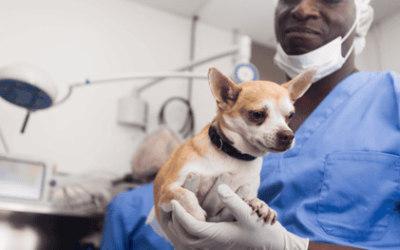How To Help My Dog to Lose Weight [Full Guide]

Obesity in dogs is a growing concern, with studies showing that up to 60% of dogs in the United States are overweight or obese. This condition can have serious consequences for a dog’s health, including an increased risk of joint problems, heart disease, diabetes, and other chronic conditions. Understanding the causes and risks of dog obesity is the first step in helping your furry friend achieve a healthier weight.
Factors that can contribute to dog obesity include:
- Overfeeding, especially with high-calorie treats and table scraps
- Lack of regular exercise and physical activity
- Certain medical conditions, such as hypothyroidism or Cushing’s disease
- Genetics and breed predispositions
Recognizing the signs of obesity in your dog, such as a visible waistline, difficulty breathing, and decreased activity levels, is essential for improving their health.
The Benefits of Dog Weight Loss
Helping your dog lose weight can have a significant positive impact on their overall well-being. By achieving a healthy weight, your dog can experience:
- Improved joint and mobility: Excess weight places additional strain on a dog’s joints, leading to pain, stiffness, and an increased risk of conditions like osteoarthritis. Losing weight can alleviate these issues and improve your dog’s quality of life.
- Reduced risk of chronic diseases: Obesity is linked to a higher incidence of conditions like heart disease, diabetes, and certain types of cancer. Maintaining a healthy weight can help prevent these life-threatening illnesses.
- Increased energy and stamina: Carrying extra weight can make it more challenging for dogs to engage in physical activity and exercise. Shedding those extra pounds can result in a noticeable boost in energy, allowing your dog to enjoy playtime and outdoor adventures more fully.
- Enhanced respiratory function: Overweight dogs may experience breathing difficulties, especially during exercise or in hot weather. Losing weight can improve their respiratory health and make it easier for them to breathe comfortably.
- Longer lifespan: Studies have shown that dogs at a healthy weight tend to live longer than their overweight counterparts. Helping your dog achieve a healthy weight can contribute to their longevity and allow you to enjoy more quality time together.
Consultation with a Veterinarian
Before embarking on a weight loss journey for your dog, it’s essential to consult with a veterinarian. Your vet can thoroughly examine your dog’s overall health, and provide personalized guidance on the best approach to safely and effectively help your dog lose weight.
During the consultation, your vet may:
- Determine your dog’s ideal weight range based on their breed, age, and body condition
- Identify any underlying medical conditions that may be contributing to your dog’s weight gain
- Recommend appropriate calorie intake and a nutritious diet tailored to your dog’s needs
- Suggest a suitable exercise plan and activity levels to support weight loss
- Monitor your dog’s progress and make adjustments to the plan as needed
Working closely with your veterinarian will ensure your dog’s weight loss journey is safe, effective, and tailored to their needs.
Creating a Tailored Weight Loss Plan for Your Dog
Developing a personalized weight loss plan for your dog is crucial for achieving sustainable results. This plan should consider your dog’s unique factors, such as age, breed, activity level, and medical conditions.
When creating a weight loss plan, consider the following key elements:
- Calorie Intake
- Nutritious Diet
- Exercise Routine
- Monitoring and Adjustments
Healthy Diet and Nutrition
Implementing a nutritious, calorie-controlled diet is crucial to your dog’s weight loss journey. Here are some key considerations for a healthy dog diet:
High-Protein, Low-Fat Formulas:
Look for dog food formulas that are high in lean protein and low in fat. Protein helps maintain muscle mass during weight loss, while reducing fat intake can create a calorie deficit.
Fiber-Rich Ingredients:
Incorporating fiber-rich ingredients, such as vegetables, whole grains, and psyllium husk, can help your dog feel fuller for longer and promote healthy digestion.
Portion Control:
Carefully measure your dog’s food portions and avoid free-feeding, which can lead to overeating. Follow the feeding guidelines on the dog food label or consult your veterinarian for personalized portion recommendations.
Treat Moderation:
Limit high-calorie treats and table scraps, as these can quickly add unnecessary calories to your dog’s diet. Instead, offer low-calorie, healthy alternatives like sliced carrots or green beans.
Hydration:
Encourage your dog to stay hydrated by always providing clean, fresh water. Proper hydration can support weight loss and overall health.
Supplements:
Your veterinarian may recommend supplements such as omega-3 fatty acids or joint support formulas to complement your dog’s weight loss diet and address any underlying health concerns.
The Role of Exercise in Pet Weight Loss
Regular physical activity is a crucial component of a successful weight loss plan for your dog. Exercise helps burn calories and improves overall fitness, muscle tone, and cardiovascular health.
When developing an exercise routine for your dog, consider the following:
Gradual Progression:
Start with moderate exercise, such as short daily walks, and gradually increase the duration and intensity as your dog becomes more fit. This gradual approach helps prevent injury and ensures your dog can comfortably maintain the exercise regimen.
Variety:
Incorporate a mix of activities, such as walking, swimming, playtime, and structured training sessions, to keep your dog engaged and motivated. Variety can also help target different muscle groups and prevent boredom.
Tailored Intensity:
The appropriate exercise intensity will depend on your dog’s age, breed, and current fitness level. Consult your veterinarian to determine the optimal exercise plan that challenges your dog without exceeding their capabilities.
Environmental Considerations:
When planning your dog’s exercise routine, consider factors like weather, temperature, and terrain. Adjust the duration and intensity accordingly to ensure your dog’s safety and comfort.
Positive Reinforcement:
Treats, praise, and playtime can be used as rewards to encourage your dog’s participation and make exercise enjoyable.
Monitoring and Tracking Progress
Closely monitoring and tracking your dog’s progress is essential for the success of their weight loss journey. Regular check-ins with your veterinarian and carefully documenting your dog’s progress can help you identify what’s working and make necessary adjustments to the plan.
Here are some key elements to consider when monitoring and tracking your dog’s weight loss:
Weigh-Ins:
Weigh your dog on a consistent schedule, such as weekly or bi-weekly, using the same scale in the same location. This will help you accurately track their weight loss over time.
Body Condition Scoring:
In addition to weight, evaluate your dog’s body condition using a standardized scoring system. This can help you assess changes in their muscle tone, fat distribution, and overall body shape.
Activity Levels:
Observe and document your dog’s energy levels, stamina, and willingness to engage in physical activity. Improvements in these areas can be a good indicator of progress.
Behavioral Changes:
Note any changes in your dog’s behavior, such as increased mobility, decreased panting, or improved sleep patterns, as these can also reflect the positive impact of weight loss.
Photographic Documentation:
Take regular photos of your dog from various angles to visually track changes in their physical appearance over time.
Communication with Your Vet:
Regularly update your veterinarian on your dog’s progress, any challenges you’re facing, and any adjustments you’ve made to the weight loss plan. Your vet can provide valuable guidance and support throughout the process.
Overcoming Challenges
Helping your dog lose weight can be a rewarding but sometimes challenging process. It’s important to be prepared for potential obstacles and have strategies in place to overcome them.
Some common challenges you may face include:
Resistance to Changes in Diet or Exercise:
Your dog may initially resist changes to their routine, such as a new diet or increased exercise. Be patient, introduce changes gradually, and use positive reinforcement to help your dog adapt.
Plateaus in Weight Loss:
It’s not uncommon for weight loss to slow down or stall at times. If this happens, work with your veterinarian to reassess the plan and make any necessary diet or exercise regimen adjustments.
Emotional Attachment to Food:
Many dog owners bond with their pets through treats and table scraps. Finding alternative ways to show affection, such as playtime or cuddles, can help break this emotional attachment to food.
Lack of Motivation or Consistency:
Maintaining a consistent weight loss plan can be challenging, especially if your dog seems disinterested or you encounter setbacks. Celebrate small victories, enlist the support of family members, and stay committed to your dog’s health and well-being.
Medical Complications:
Underlying health conditions, such as hypothyroidism or Cushing’s disease, can make weight loss more difficult. Work closely with your veterinarian to address any medical concerns and adjust the plan accordingly.
How Can Pet Insurance Help You With Veterinary Expenses?
Pet insurance can be a valuable tool in managing the costs of treating a pet’s veterinary expenses. By having a pet insurance policy in place, you can have peace of mind knowing that you can provide medical care for your furry companion without worrying about the financial burden. Pet insurance can help cover the costs of veterinary consultations, diagnostic tests, medications, and even specialized treatments if required.
Reimbursement
This method is the most common for pet insurance companies. You pay out of pocket for the veterinarian bill, and then the insurance company reimburses you for what’s covered under the insurance plan. The steps look like this.
- You pay the vet bill after your dog’s visit.
- You fill out the pet insurance claim form.
- Submit the claim form and other required documentation to the insurer.
- After the claim is approved, you will be reimbursed for eligible expenses.
What Does Odie Pet Insurance Cover?
Pet insurance covers various veterinary expenses, providing financial protection and peace of mind for pet owners. Here are the details of the coverage options offered by Odie Pet Insurance:
Illness & Injury Plan
The Illness & Injury Plan is an all-inclusive insurance plan designed to cover a wide range of medical needs for your pet. This plan includes comprehensive coverage for various illnesses, injuries, and veterinary services. Some of the covered items include:
- Veterinary exams and consultations
- Diagnostics (e.g., X-rays, lab tests)
- Prescribed medications
- Surgeries and hospitalization
- Rehabilitation, acupuncture, or chiropractic treatments
- Medically necessary supplies
- Euthanasia and cremation
The Wellness Plan
The Wellness Plan is a monthly membership that focuses on preventive care and covers routine veterinary services.
- Provides reimbursements for routine care items such as wellness visits (exams and vaccines), testing and parasite prevention, dental cleanings and at-home dental care, vitamins, supplements, and more.
- Through Odie’s partnership with Petivity, a leader in smart pet products and proactive care, Wellness Plan members can also receive reimbursements for Petivity devices and health kits, as well as eligible Purina food and supplements.
- Total reimbursement up to $700 per year.





